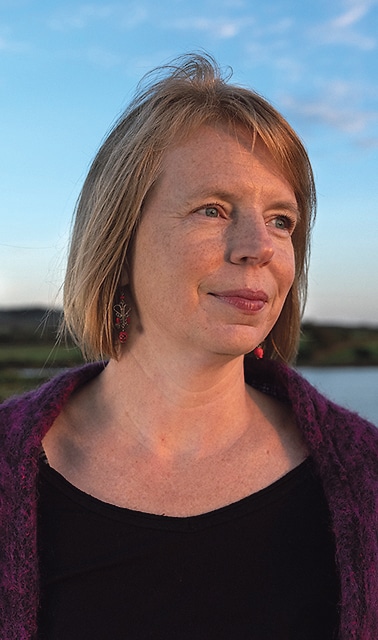
End of Life Matters
End of life Doula Melissa Murphy, a companion, guide and resource supporting our community in end of life matters.
www.starsbeyondourskin.com

‘Babies Beneath My Feet’ – a handwritten plaque observed at the site of the former St. Mary’s Mother and Baby Institution Tuam, Co. Galway where a small grotto created decades ago remains.
I have just returned from a gathering of Irish and international retreatants, who joined together for five days to honour and remember the mothers and children who were institutionalised in mother and baby ‘homes’. Going forward, I’ll swap the word home for institution; having learned from those with lived experience that these places were the furthest thing from being home-like. Until recently, I’d assumed most people were aware of them, but have found myself educating friends and family in America unfamiliar with the religious-run places active during the 18th to late 20th century in Ireland (and beyond I’ve also since learned). Such institutions were synonymous with secrecy, concealment and religiosity. They condemned sex and pregnancy outside marriage and influenced wider condemnation of the same. In essence, unmarried women who became pregnant were deemed ‘fallen’ and, along with their children, experienced grave abuses of their human rights. The men who fathered these children faced no such consequences while the women had to give birth within the walls of the institutions, then relinquish their babies without choice. Ireland is still coming to terms with how its wider society perpetuated this shame and how it enabled the systems that arose to contain and conceal it. I recall first hearing about this not-so-distant history about twenty years ago when a friend suggested I watch ‘The Magdalene Sisters’. A decade or so later ‘Philomena’ became slightly more known as a film, but this past week has been something else altogether.
The invitation of our collective was to “bear witness and listen to the soul of these unfathomable places”. A former magdalene laundry site (such a place committed women for an array of reasons not limited to disability or mental illness) on Sean MacDermott street in Dublin began our plunge into what was hardly known to me – a fairly avid film watcher and reader. A well-known activist and survivor (this too is a word many have described loathing, but I’ll use it interchangeably alongside ‘someone with lived experience’) spoke to us for some time in a dialogue where questions were generously welcomed. The building is not open to the public, as future plans for a national centre for research and remembrance is to be created there. We were told that no invitation for input from survivors has been extended. Another morning was spent at Tuam in Co.Galway, and I have few words to describe what it meant to stand in solidarity in the rain and wind listening to another with lived experience share her story; or that the nearby playground has a sign that reads: ‘caution this playground is closed until further notice’. The remainder of the land will also be closed off for exhumations shortly; so many have been anticipating this for years. The majority of our time was spent in Roscrea at Sean Ross Abbey, which closed in 1969, but still stands, well-preserved and currently repurposed as a direct provision centre. We were there too because there’s a good bit of land including significant graveyards. We also had the support of the landowner and current employees for our group to spend purposeful time there. A number of others with lived experiences arrived over the days to share and be in conversation. Time is different in these spaces – having little sense of how much of it is passing. We engaged in a number of spiritual ceremonies including reading the names of the dead, immersed in talking circles, healing walks and much more.
As I compose this, I recall too some of the countless moments that were especially impactful. Spontaneously they’re here in no particular order: 1. Walking the land in Roscrea (44 babies graves found, yet over 1,000 children died there) and Tuam (796 buried sans graves) contending with the understanding that there are babies, infants and women (at Roscrea) in the earth there and much more infinitely unknown. 2. Standing in a room where the incarcerated women gave birth, I am listening to a survivor and a building caretaker sharing stories; suddenly feeling overwhelmed by their voices in those moments. The rooms are extremely, heavily insulated so the sounds were intensified. I was told that this was intentional for the birthing rooms, as was limited medical care, poor living conditions, lack of support and so on. 3. Noticing the birdsong in uniquely apt moments and other sounds of life (honking cars – likely the result of a wedding) that carried on as we moved in an almost parallel universe through moments. 4. Witnessing story after story of survivors – whose bodies remember these places – sharing, chatting, embracing one another, even having the craic – being present to moments of healing in real time that are without words really! 5. Receiving poetry read by the survivors in the intimate spaces we’d shared, as well as one offered for this piece. 6. The privilege of also listening to the humanity of others living with/healing from trauma, ruptured family, the impacts of adoption and so on. 7. Our collective ceremony of reading the names of the dead at the memorial garden at Sean Ross – the echoes of the names. And as an aside, the utter disbelief in the cruelty that each baby or infant had been deemed a ‘spinster’ or ‘bachelor’ in lieu of gender. 8. Witnessing a survivor spontaneously and with big energy (as one of my fellow reatreatants described) tidy around the graves of Michael Hess (of Philomena Hess) and the children’s memorial site in Roscrea. 9. Learning that some of the migrant community housed at Sean Ross have had conversations with Ireland-born survivors who return to visit; though their stories and homelands are worlds apart, there’s been mutual witnessing of their shared trauma…
This has been my fifth bearing witness journey and each plunge (as in diving into the unknown) that I’ve taken in the United States, Poland and now Ireland, are the most profound of experiences. Each has been an opportunity for being with the wholeness of life. As someone who supports community around end of life; accompanying people around grief and loss, it feels crucial to continue understanding what lies beneath the Irish landscape. I’m deeply grateful to the events and people who connect me to these spaces and to a dear friend who first told me about the late Bernie Glassman, founder of Zen Peacemakers and inspirer of these global retreats. Bernie had said “may I have the courage to bear witness, to see the others as myself and myself as the others.”
You see – I was a Nobody / It started off with my name / My name was Shame
I then became a Somebody / which then became your name / Your name was Respectability
Now I’m not just Anybody / This is illegitimacy in a nutshell
– Teresa O’Sullivan, on her birth story at Tuam’s mother and baby institution
A couple of tried and tested resources on this topic:
‘Stolen’, 2023 documentary, by Margo Harkin. Featured on RTE, now on many digital platforms
‘Republic of Shame: Stories from Ireland’s Institutions for Fallen Women’ by Caelainn Hogan
To learn more or to connect with Melissa, email her at starsbeyondourskin@gmail.com or visit www.starsbeyondourskin.com. She also welcomes your questions or ideas for future columns.


